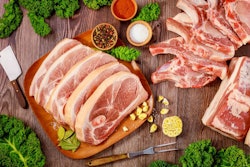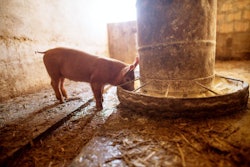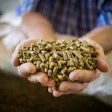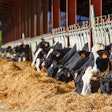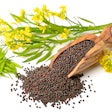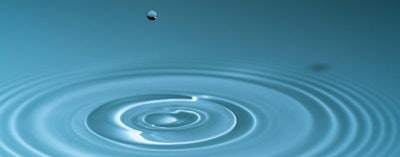
Proper water intake plays a role in dairy cow health, welfare and productivity.
Milk is approximately 87% water. For a dairy cow to produce 30 liters of milk, she needs to use just over 26 liters of water. While the importance of water is often cited, in practice, it is sometimes overlooked. Trough design, function and location — as well as cleanliness — are not always given the priority they deserve. Additionally, it’s been estimated that dairy cattle account for approximately 19% of the total global water footprint related to animal production, with 98% of that going to produce feed and ~1% used for drinking.
Inadequate water provision has the capacity to significantly reduce milk production and health and welfare of dairy cattle such that it should be at the forefront of any management process.
Roles of water in the body
Water is considered the most important nutrient for health and performance in dairy herds. It’s a small, simple molecule, but it is essential for life. The chemical and physical natures of this compound are unusual and make it ideally suited to driving many hundreds of biochemical and physiological processes, and a certain amount of water is needed in cells for metabolic activity.
Water is comprised of one oxygen atom and two hydrogen atoms. The negatively charged oxygen is orientated opposite the positively charged hydrogens, making the molecule polar, i.e. it has two opposing poles. That said, the overall charge of the molecule is neutral as the two positively charged hydrogens cancel out the 2- charge of the oxygen. The result is a polar but non-ionic molecule, which renders it an excellent solvent, particularly for ionic and polar molecules, such as salts, sugars, simple alcohols, ketones and amines.
Water is able to dissociate, which gives it some electrical conductivity that can pass electrical properties to solutions. It dissociates into hydroxide (OH–) and hydrogen (H+) ions that are involved in protein structure, membrane function and other processes. Differences in H+ either side of biological membranes permits movement of solutes and other ions across them. This function is critical to mechanisms responsible for the transport of energy. Hydrolytic reactions (using water to split molecules) are used extensively in the digestion of food. The enzyme urease is a good example:
H2N – CO – NH2 + 2H2O + H+ Þ 2NH4– + HCO3–
The buffering action of the dissociation of bicarbonate in blood and the rumen involves water:
H2CO3 «H+ + HCO3–
Interaction with water via H bonds is crucial in the formation of biological membranes and compartments. Phospholipids involved in the phospholipid bilayer are amphiphilic so contain both hydrophobic (water “hating”) and hydrophilic (water “loving”) sections. In aqueous solutions, they are able to orient themselves with the non-polar (hydrophobic) fatty acid tails pointing inwards and towards each other with the polar (hydrophilic) heads pointing outwards and interacting with the water.
The process of osmosis is the movement of water from a low to a high concentration of solutes across a semi-permeable membrane with the aim of equalizing the concentration of solutes on either side of that membrane, i.e. achieve equilibrium. Osmosis is the primary way water moves in and out of cells and disruption of this process can have catastrophic effects on tissues at the cellular level. Osmosis is also the mechanism by which plants take up water from the soil. By maintaining a high concentration of solutes in the root cells water automatically moves from the soil into the roots as it tries to reach equilibrium. Water is also known for its high surface tension, created by strong molecular interactions, permitting rapid capillary uptake.
Two properties of water that are essential to terrestrial organisms is its very high specific heat capacity and its high heat of vaporization. Both these properties allow animals to resist thermal change. The former refers to the fact that it takes a lot of heat to increase the temperature of water by one temperature unit, meaning that comparatively large amounts of heat must be absorbed to alter body temperature. The latter, high heat of vaporization, indicates that it takes a substantial amount of energy for water to change state, e.g. from liquid to vapor. This allows an animal to transfer a significant amount of heat to the environment with a small loss in volume. It also means it’s possible to buffer temperature changes through processes, such as evaporation, condensation, melting and freezing. Animals can use some of these processes to effectively regulate their temperature, with sweating and panting good examples.
 Water’s chemical and physical nature is unusual — making it ideally suited for driving many hundreds of biochemical and physiological processes in cows. (Fabrikafoto | BigStock.com)
Water’s chemical and physical nature is unusual — making it ideally suited for driving many hundreds of biochemical and physiological processes in cows. (Fabrikafoto | BigStock.com)Sources and losses of water
There are several sources of water and several routes of water loss. Losses include water in milk, urine, feces and various types of evaporation. Sources of water consist of drinking, feed and metabolic (oxidation) water. Drinking water (free water) is the most obvious source of water for animals, including dairy cows, and daily intake varies significantly depending on many factors, including dry matter intake (DMI), environmental conditions and water availability.
There will also be water within the diet and intake of feed water will be mainly governed by diet organic matter (OM) concentration, which has been linked to water consumption. It makes sense then that increased dietary DM usually results in increased free water intake. It seems that water consumption increases, but total water intake decreases, as DM percentage of the diet increases. An additional source of water comes in the form of metabolic water, that is, water generated from bodily processes, such as the oxidation of lipids, proteins and carbohydrates. It forms a small, but important, contribution to overall water “intake.”
Losses generally fall into four categories: urinary, fecal, milk and evaporative. There may be others, such as resulting from blood loss, but they would not be considered usual. Urinary loss of water varies according to many factors but according to research, losses of ~25kg/d are not uncommon. Increased water absorption and increased urinary nitrogen (N) and potassium (K) excretion contribute to higher water losses via urine.
The converse is true when dietary DM and milk production are high. In the normal situation fecal water losses tend to be less variable than urinary losses and are thought to be affected by the digestibility of the diet. Rate of passage will also have an effect, particularly noticeable when an animal is affected by scours. Milk is predominantly water and so is a major route of water loss. That said, milk production is linked with DM intake (DMI) and there is a correlation between water intake and DMI, meaning milk production per se may not be driving water flux.
Finally, evaporative losses, such as from sweat, saliva (panting) and nasal secretions, all contribute to water loss from the body. Again, these are all affected by numerous factors many of which will be described in the subsequent text.
Dairy cow water intake
A dairy cow is anything from ~60-80% water, most of which resides within cells. The remainder is found in the gastrointestinal tract, in blood and between cells. Ruminants differ from non-ruminant animals due to the production and secretion of a great deal more saliva during eating, as well as the large amount of fluid stored in the rumen, both of which contribute to buffering osmotic changes in the rumen created by feed entering it.
Voluntary water consumption in dairy cows is affected by many factors. Some of the most influential are DMI, the nature of the diet, milk production and ambient temperature. Factors known to be positively correlated with water intake are average ambient temperature, milk production, DMI, DM content of the ration, body weight, lactation number and day (likely related to milk production), sodium (Na) intake and K intake with relative humidity and dietary roughage content negatively correlated.
Mean voluntary water intake increases by 2.30 kg per cow per day for every additional kg DM consumed and also increased by 0.053 kg per cow per day for each g/kg increase in dry matter concentration.
Free water intake means of 82 liters/day and 84 liters/day, respectively, with DMIs of ~23kg/d.
Factors affecting intake
Environmental factors, such as diet composition, climatic conditions and animal factors cannot only affect water intake, but also drinking behavior.
Animals fed clover, for example, increased water intake, which can be attributed to the higher protein (N) and K levels compared with grass and other forages. Grazing animals will also have a much higher proportion of their water intake from their ration due to the high water content of grass and other fresh crops. For example, if a cow eats 50 kg of grass with a 20% moisture content, the pasture alone will provide ~40 liters of water. The remainder (~40 liters) will need to be made up of drinking water.
It is also important to note that in environments with high temperature and humidity, additional drinking water would need to be consumed to meet the increased needs of the animal. It makes sense then that housed cows drink more “free” water compared with their grazing counterparts, especially with increasing temperature and humidity.
Hierarchy also has an impact. Subordinate animals that are low down in the pecking order have been seen to visit water troughs at the least competitive times of the day, again highlighting the need for sufficient water provision to accommodate this. Drinking behavior is often linked to feeding and water is usually consumed in association with eating.
Temperature of the water appears to influence voluntary water intake and the effect is more pronounced at extremes of temperature. Interestingly, it has been shown that cows drank more heated water (30–33°C) compared with ambient ground water (7–15°C) with a stronger preference for the heated water at lower environmental temperatures.
Restriction or inadequate provision of water has been shown to result in rapid but reversible reductions in DMI and milk production. That said, dairy cows have the amazing ability to cope with sustained and substantial restriction of water intake, e.g. ~44% of total water intake. Part of this they ascribe to the huge fluid reservoir that is the rumen but cite that, with continuing restriction, other mechanisms come into play, including reduced DMI. Smaller meals reduce the osmotic load and thus reduce the amount of water required to balance that load. They suggest that this reduction in feed intake is a compromise between nutrient needs and minimizing the negative consequences of dehydration.
Water and animal welfare
In the European Union (EU), there are regulations that govern the provision of water to dairy cows, which state that they must have “appropriate access to adequate supplies of water of suitable quality, so as to maintain their full health and vigor and to meet their behavioral and physiological needs.” However, there are many interpretations of what adequate water supply is, particularly when it comes to how much drinking space should be provided.
Research has shown that cows prefer to drink from troughs and those troughs should allow a drinking rate of up to 24 liters/minute. That said, there is little literature on the more detailed aspects of dairy cow drinking behavior and consumption in general.
Water is essential to life and to dairy cow health, welfare and production, but the optimal provision of clean drinking water is often overlooked in favor of other nutritional and management aspects. Many an operation can yield increases in milk simply by ensuring troughs are clean, provide sufficient drinking space and refill quickly enough.
References available upon request.


